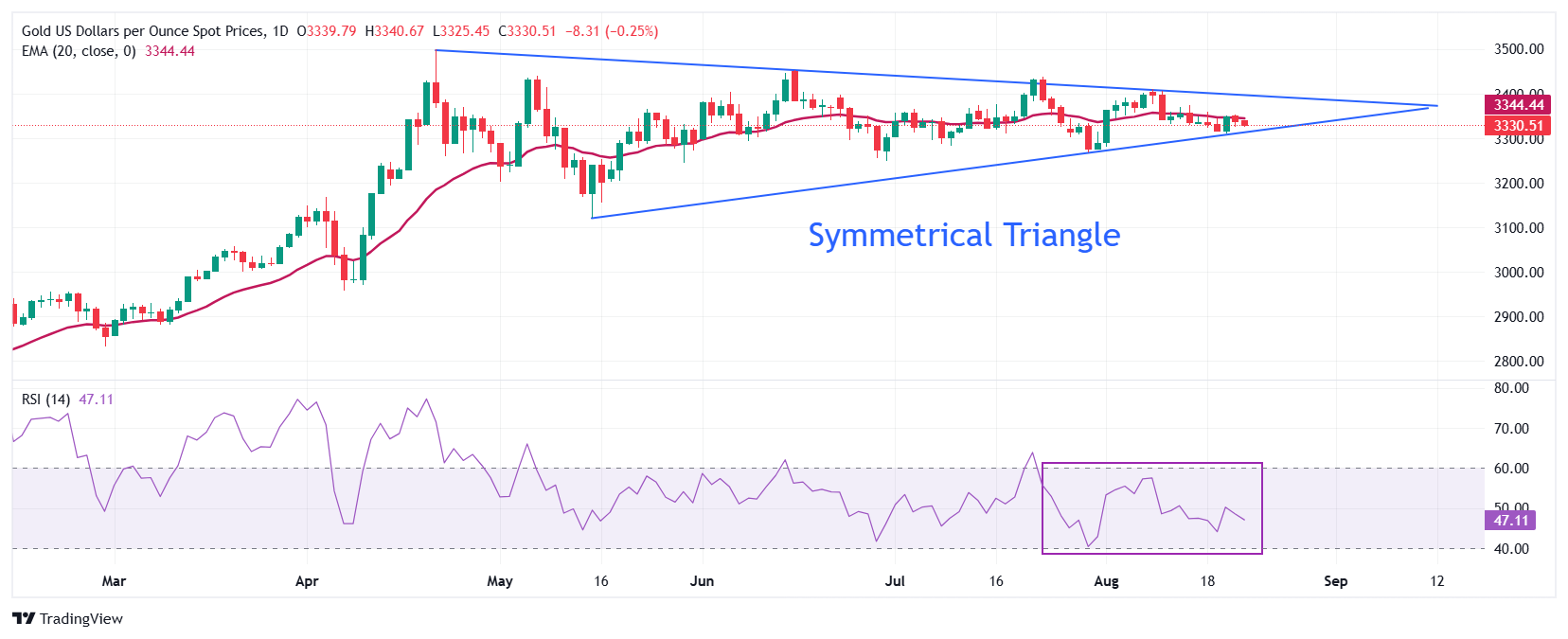Gold Price Forecast: XAU/USD trades cautiously near $3,330, Fed Powell’s speech in focus
- Gold price faces selling pressure ahead of Fed Powell’s speech at the Jackson Hole Symposium.
- Fed’s Powell is expected to reiterate a “wait and see” approach on the monetary policy outlook.
- Traders trim Fed dovish bets ahead of Jerome Powell’s speech.
Gold price (XAU/USD) trades 0.3% lower around $3,330.00 during the European trading session on Friday. The precious metal faces selling pressure as market experts believe that Federal Reserve (Fed) Chair Jerome Powell could reiterate his argument that a “wait and see” approach on the interest rate outlook is appropriate in the current environment in his speech at the Jackson Hole (JH) Symposium at 14:00 GMT.
“The most likely scenario is that Powell won’t provide any definitive clues on what the Fed will do next ahead of critical non-farm payrolls and CPI data,” analysts at Commonwealth Bank said.
The Federal Open Market Committee (FOMC) minutes of the July monetary policy meeting also showed on Wednesday that a majority of members, including Jerome Powell, underscored the need for time to gain absolute clarity on the “magnitude and persistence of higher tariffs’ effects on inflation”.
Ahead of Fed Powell’s speech, traders have also trimmed bets supporting interest rate cuts by the Fed in the September meeting. According to the CME FedWatch tool, the probability of the Fed cutting interest rates in September has eased to 73.3% from 85.4% seen a week ago.
The maintenance of interest rates at higher levels by the Fed bodes poorly for non-yielding assets, such as Gold.
Traders raised Fed dovish bets earlier this month after the release of the Nonfarm Payrolls (NFP) report for July, which showed a significant revision in newly employed workers in May and June on the downside.
On the global front, growing uncertainty over peace between Russia and Ukraine is expected to continue supporting the Gold price. On Thursday, Moscow launched a mass attack on targets in Ukraine. This came at a time when US President Donald Trump is persuading leaders from both nations to end the three-year-long war.
Gold technical analysis
Gold price trades in a Symmetrical Triangle, which indicates a sharp volatility contraction. The upper border of the above-mentioned chart pattern is plotted from the April 22 high around $3,500, while the downward border is placed from the May 15 low near $3,180.86.
The yellow metal wobbles near the 20-day Exponential Moving Average (EMA) around $3,351.00, indicating a sideways trend.
The 14-day Relative Strength Index (RSI) oscillates inside the 40.00-60.00 range, suggesting indecisiveness among market participants.
Looking down, the Gold price would fall towards the round-level support of $3,200 and the May 15 low at $3,121, if it breaks below the May 29 low of $3,245.
Alternatively, the Gold price will enter an uncharted territory if it breaks above the psychological level of $3,500 decisively. Potential resistances would be $3,550 and $3,600.
Gold daily chart

Gold FAQs
Gold has played a key role in human’s history as it has been widely used as a store of value and medium of exchange. Currently, apart from its shine and usage for jewelry, the precious metal is widely seen as a safe-haven asset, meaning that it is considered a good investment during turbulent times. Gold is also widely seen as a hedge against inflation and against depreciating currencies as it doesn’t rely on any specific issuer or government.
Central banks are the biggest Gold holders. In their aim to support their currencies in turbulent times, central banks tend to diversify their reserves and buy Gold to improve the perceived strength of the economy and the currency. High Gold reserves can be a source of trust for a country’s solvency. Central banks added 1,136 tonnes of Gold worth around $70 billion to their reserves in 2022, according to data from the World Gold Council. This is the highest yearly purchase since records began. Central banks from emerging economies such as China, India and Turkey are quickly increasing their Gold reserves.
Gold has an inverse correlation with the US Dollar and US Treasuries, which are both major reserve and safe-haven assets. When the Dollar depreciates, Gold tends to rise, enabling investors and central banks to diversify their assets in turbulent times. Gold is also inversely correlated with risk assets. A rally in the stock market tends to weaken Gold price, while sell-offs in riskier markets tend to favor the precious metal.
The price can move due to a wide range of factors. Geopolitical instability or fears of a deep recession can quickly make Gold price escalate due to its safe-haven status. As a yield-less asset, Gold tends to rise with lower interest rates, while higher cost of money usually weighs down on the yellow metal. Still, most moves depend on how the US Dollar (USD) behaves as the asset is priced in dollars (XAU/USD). A strong Dollar tends to keep the price of Gold controlled, whereas a weaker Dollar is likely to push Gold prices up.






